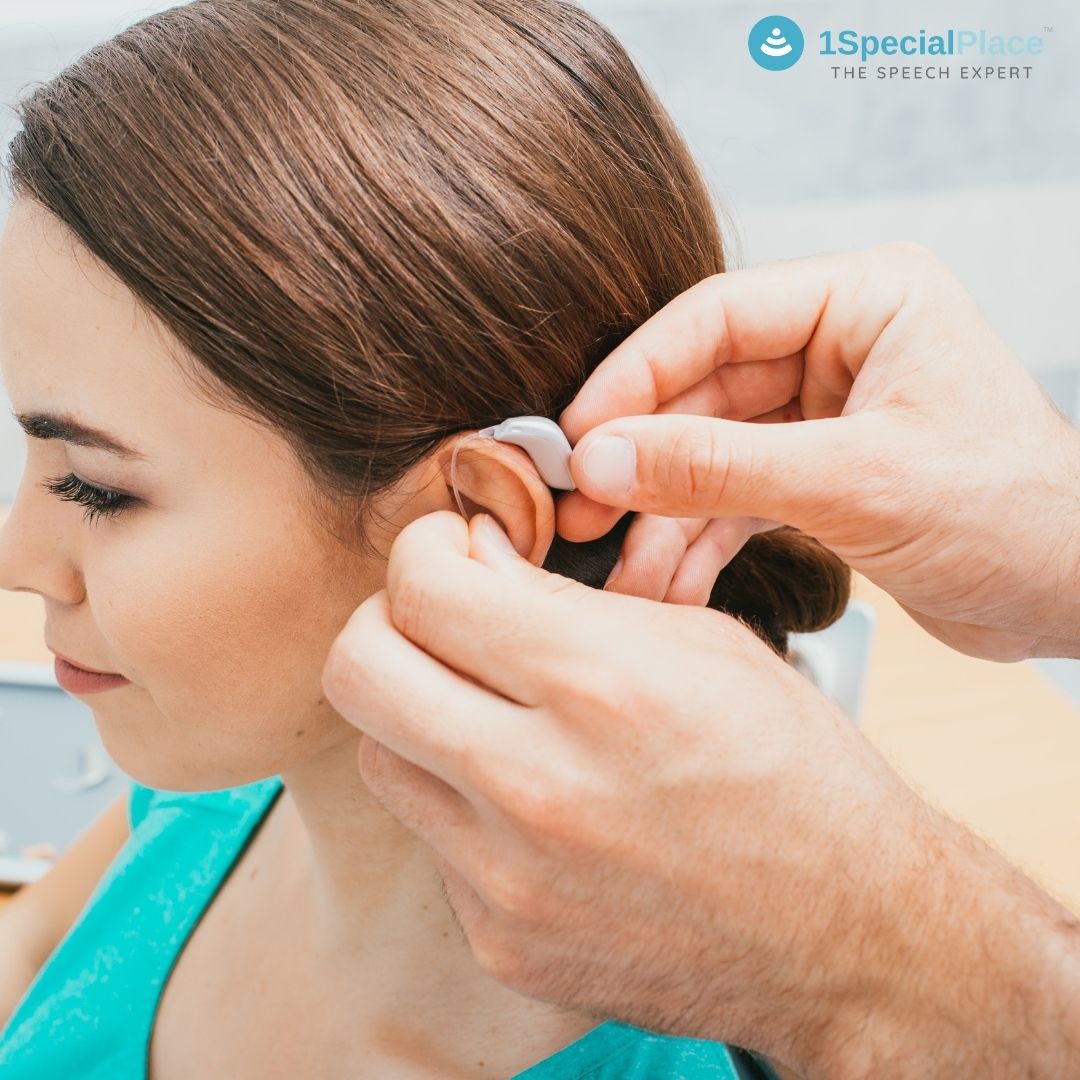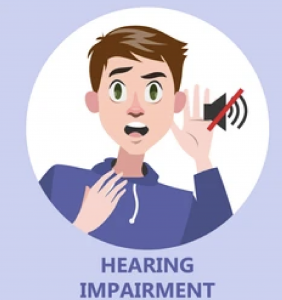
Online Intervention For Hearing Loss
Online Intervention For Hearing Loss
Hearing impairment or hearing loss refers to difficulty listening to conversational speech or loud sounds. Similarly, these factors vary from genetic to hearing loss due to old age. Hearing loss is caused by problems in the outer ear, middle ear, and inner ear.
In the same vein, living with hearing loss can be difficult but there are numerous solutions to this problem. Learning about the causes, type, severity, treatments, and prevention of hearing loss can be easier to understand how it impacts you and your loved ones.
The earlier a deaf or hard-of-hearing child receives services, the more likely his or her speech, language, and social skills will reach their full potential.
Early intervention services, according to research, can significantly improve a child’s development.

What exactly is childhood hearing loss?
A child may be diagnosed with hearing loss if they can’t hear sounds below a certain level of volume in either one ear (known as unilateral) or both ears, depending on the results of the hearing test (bilateral). The most basic threshold is usually around 15 to 20 decibels (dB), which is roughly equivalent to the sound of leaves rustling or people whispering.
Even though being unable to hear leaves rustling is considered a mild degree of hearing loss, it will make understanding certain parts of speech more difficult. That is why treating hearing loss in children is critical, as they begin learning language as soon as they are born.
Children with normal hearing have auditory processing disorder.
Some children may pass traditional hearing tests but still struggle to listen to and understand speech, especially in noisy situations. They may frequently ask you to repeat what you’ve said and may struggle to distinguish between similar sounding words. If this describes your child, you should consult with a doctor because he or she may have auditory processing disorder. This means that the ears can detect sound adequately, but the brain struggles to correctly interpret the sound.
Symptoms of hearing loss
- Difficulty in having a conversation
- Having to increase the volume of the television or the radio
- Unable to hear someone in a crowded area
- Unable to bear loud sounds
- Sense of exhaustion after trying to listen to people all-day
- Occasional ringing sensation in the ear / Tinnitus
During the first 45 days after a child is born, the hospital conducts hearing screening for a potential hearing loss. If the screening test results indicate “refer”, a comprehensive hearing testing can confirm the presence of the hearing loss. After which, we can gather more information regarding the type, degree and treatment options. Pediatric audiologists diagnose children with hearing impairment, they dedicate themselves to the special needs of babies and children with hearing impairment.
Congenital factors, medication, or deformities are some of the causes of hearing impairment in children. This can help the audiologist plan a treatment program. Additionally, identification and treatment programs prior to 6 months can improve outcomes tremendously.
Causes of hearing loss in children can be:
- Congenital hearing loss or hearing loss since birth
- Infections, such as rubella or herpes simplex virus
- premature birth
- low birth weight
- birth injuries
- drug and alcohol use while pregnant
- jaundice and Rh factor problems
- maternal diabetes
- high blood pressure while pregnant
- genetics and syndromes
IDENTIFICATION OF HEARING LOSS
Understanding the features of hearing loss is an essential first step. After you identify it, you can take your child or your loved one to an audiologist. They will be able to determine the type, degree, and severity of your hearing loss and also provide possible solutions like hearing aids, cochlear implants and auditory training. Hearing loss in school-aged children could be because of medications, infections, genetic conditions or exposure to loud noise. In that case, one must take your child to an Ear, Nose and Throat (ENT) Specialist who will refer you to a pediatric audiologist.
UNDERSTANDING HEARING AIDS
In this paragraph, we are going to talk about hearing aids. They are small instruments that pick up sound from the environment and amplify it, after which we can hear better. It has the technology to reduce unwanted sounds and filter the speech sounds required for conversation. However, hearing aids for children are different from those that are made for adults.
Some children benefit from a hearing aid, but they may hear much better through a cochlear implant.
AUDITORY TRAINING VS AUDITORY-VERBAL THERAPY
A child will be able to perceive sounds after they are fitted with hearing aids and cochlear implants. Speech and language therapists ensure that children reach speech, language, and auditory milestones.
Two types of training can be provided to children with hearing loss.
Read here about Hearing Aid Maintanence Tips
Auditory verbal therapy
- It is a family-centred training program that equips the parents and the caregivers to help the child attain age adequate speech and language skills. In addition, parents play an integral part in this process since they are trained on how to troubleshoot the aid and teach the child how to make the best possible use of the amplification device (Hearing aids or cochlear implants). The difference between auditory verbal therapy and traditional speech and language therapy is that the child maximizes his listening potential without the help of visual cues.
Auditory training
- Auditory training helps individuals process information better. The brain and the ears are a team. It enables the brain to improve its auditory processing capabilities. With guided practice, the program can improve listening accuracy and memory. In conclusion, a child’s processing ability can improve by auditory and visual stimulation.It targets whole words and sentences rather than single sounds.
AURAL REHABILITATION ACTIVITIES
Auditory detection
Detection is the ability to respond to the presence or absence of sound. It is the essential first step in learning to listen. Conditioned play response requires the child to perform an action upon hearing a sound. (Example: placing a block in a bucket, stacking rings on a pole, or putting a plastic animal in a bucket of water).
Auditory discrimination
Discrimination is the ability to perceive similarities and differences between two or more speech stimuli. Using same-different tasks in discrimination activities. (Example: dog vs dogs, “Do they sound the same or different?”) The child learns to respond differently to different sounds.
Auditory Identification:
Identification is the ability to label by repeating, pointing to or writing the speech stimulus heard. Identification involves the suprasegmentals & segmentals of speech.
Suprasegmentals: duration, loudness, pitch, rhythm, stress, or intonation.
Segmentals include initial sounds, words varying in several syllables, one-syllable words that differ in vowels and consonants, and stereotypical messages such as familiar expressions or directions.
Auditory Comprehension:
Comprehension is the ability to understand the meaning of speech by answering questions, following directions, paraphrasing, or participating in a conversation.
Comprehension requires auditory memory and follows an auditory sequence:
- Following single directions and two directions
- Following classroom instructions
- Sequencing three events in a story
- Answering questions about a story: closed set and open sets
- Listening in noise
- Description of environmental sounds
Early intervention
As soon as the child is born to go for a hearing screening if there has been any medical condition- fever/ pneumonia/ late birth cry, etc. Get a hearing aid/ cochlear implant as soon as possible. It helps the child to enter into the world of hearing soon.
Auditory attention:
There are a lot of computer-based programs with pre-recorded auditory discrimination, detection and memory tasks which persons with hearing impairment can use for practice at home. Children use gadgets for learning and gaming.There are several apps that teach phonetics, learning and vocabulary.
Services for Families
Many parents are surprised by their child’s hearing loss. Parents may require additional time and support to adjust to their child’s hearing loss.
Parents of children who have recently been diagnosed with hearing loss can seek various types of assistance. Advice, information, the opportunity to meet other parents who have a child with hearing loss, locating a deaf mentor, finding childcare or transportation, giving parents time for personal relaxation, or simply being a supportive listener are all examples of support.
In conclusion, living with hearing loss can be difficult. But trained speech language pathologists and audiologists can teach you strategies on how to hear better, which will in turn make your life easier.
Read here about Intervention for adult
- Amazon purchases for your child’s speech development - January 31, 2023
- Functional Writing Activities for Individuals with Aphasia - January 23, 2023
- AAC for Adults with Communication Difficulties - January 16, 2023

Leave a Comment
(0 Comments)